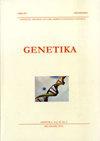儿童乳糜泻与染色质重塑基因表达的关系
4区 农林科学
Q3 Agricultural and Biological Sciences
引用次数: 0
摘要
乳糜泻(CD)是一种免疫依赖性全身性疾病,发生在遗传易感个体中,导致小肠损伤。众所周知,染色质重塑是一种表观遗传机制,与慢性炎症相关的胃肠道疾病有关。然而,没有关于CD和染色质重塑之间联系的信息。为此,我们评估了根据Marsh分类和HLA谱诊断为CD的儿童中染色质重塑组基因的表达谱,并探讨了它们与CD的关系。本研究包括40例诊断为CD的儿童和30例健康儿童的石蜡块包埋内镜活检。筛选人白细胞抗原(HLA)基因中最常见的4个与CD相关的突变(DQA1*05、DQB1*02、DQA1*03和DQB1*03:02)。采用肠道活检标本进行mRNA分离和cDNA合成。采用Real-Time qPCR分析染色质重塑组(SWI/SNF复合物组:ARID1A, Polycomb组:CTBP1,核小体重塑和组蛋白去乙酰化酶(NuRD)复合物组:MTA1, Chromobox/Heterochromatin Protein 1 (HP1)同源物组:CBX3和CBX7,同源结构域(PHD)蛋白组:NSD1,生长抑制剂(ING)家族组:ING 5)中共7个基因的表达情况。使用制造商提供的软件在线进行数据分析。与对照组比较,CD组检测到ARID1A、CTBP1和NSD1基因过表达,但差异无统计学意义(p=0.31、0.33和0.33)。有腹泻症状(典型)的CD组与无腹泻症状(不典型)的CD组比较,CBX3和CTBP1基因的低表达有统计学意义(p=0.04和p=0.004)。CTB1过表达在Marsh 2 CD病例中有统计学意义(p=0.03)。HLA DQ2/DQ8阳性CD患者组与对照组比较,NSD1、CBX3、EED基因过表达(p=0.75、0.75、0.78),CBX7、MTA1、ARID1A、CTBP1基因过表达(p=0.74、0.75、0.75、0.75)。这是第一个报道染色质重塑基因的表达可能在CD的发生和进展中起作用的研究。该病例对照研究的结果有待于未来更多受试者的研究来证实,以获得具有统计学意义的结果。本文章由计算机程序翻译,如有差异,请以英文原文为准。
Relationship between pediatric celiac disease and chromatin remodeling gene expressions
Celiac disease (CD) is an immune-dependent systemic disorder that occurs in genetically predisposed individuals resulting in damage in the small intestine. It is known that chromatin remodeling, an epigenetic mechanism, is associated with gastrointestinal diseases associated with chronic inflammation. However, no information is available on the link between CD and chromatin remodeling. For this purpose, the expression profiles of chromatin remodeling group genes in children diagnosed with CD according to Marsh classification and HLA profile were evaluated and their relationship with CD was investigated. Endoscopic biopsies embedded in the paraffin block of 40 children with CD diagnosis and 30 healthy children were included in the study. The most common four mutations (DQA1*05, DQB1*02, DQA1*03, and DQB1*03:02) related to CD on human leukocyte antigen (HLA) gene were screened. Intestinal biopsy samples were used for mRNA isolations and cDNA synthesis. Expressions of total seven genes in the chromatin remodeling groups (SWI/SNF Complex Group: ARID1A, Polycomb Group: CTBP1, Nucleosome-Remodeling & Histone Deacetylase (NuRD) Complex Group: MTA1, Chromobox/Heterochromatin Protein 1 (HP1) Homologs Group: CBX3 and CBX7, Homeodomain (PHD) Protein Group: NSD1, Inhibitor of Growth (ING) family group: ING 5) were analyzed by Real-Time qPCR. Data analysis was performed online using the software provided by the manufacturer. Overexpression in ARID1A, CTBP1, and NSD1 genes was detected when the CD group was compared against the control group, however they were not significant (p=0.31, 0.33, and 0.33). When CD group who had diarrhea symptom (typical) were compared to the CD group without diarrhea symptom (atypical), statistically significant under-expression was found in CBX3 and CTBP1 genes (p=0.04 and p=0.004). Statistically significant CTB1 overexpression was detected in Marsh 2 CD cases (p=0.03). In the comparison of HLA DQ2/DQ8 positive CD patient group with the control group, the NSD1, CBX3, and EED (p=0.75, 0.75, and 0.78) genes were over-expressed and the CBX7, MTA1, ARID1A, and CTBP1 genes (p=0.74, 0.75, 0.75, and 0.75) were under-expressed. This is the first study to report that expression of chromatin remodeling genes may have roles in the development and progression of CD. The results of this case-control study are open to confirmation by future studies with larger number of subjects to obtain statistically significant results.
求助全文
通过发布文献求助,成功后即可免费获取论文全文。
去求助
来源期刊

Genetika-Belgrade
AGRONOMY-GENETICS & HEREDITY
CiteScore
1.80
自引率
0.00%
发文量
1
审稿时长
6-12 weeks
期刊介绍:
The GENETIKA is dedicated to genetic studies of all organisms including genetics of microorganisms, plant genetics, animal genetics, human genetics, molecular genetics, genomics, functional genomics, plant and animal breeding, population and evolutionary genetics, mutagenesis and genotoxicology and biotechnology.
 求助内容:
求助内容: 应助结果提醒方式:
应助结果提醒方式:


